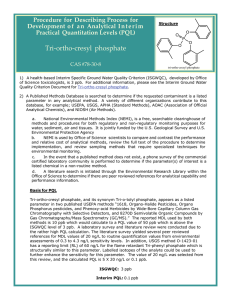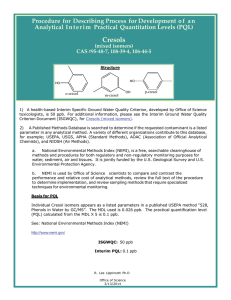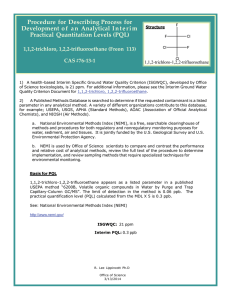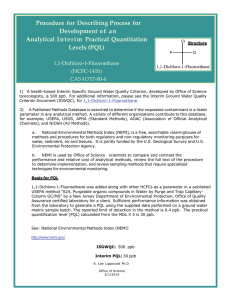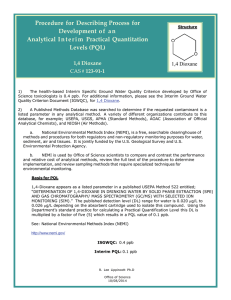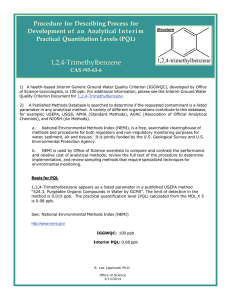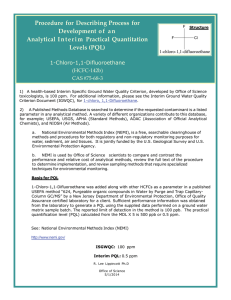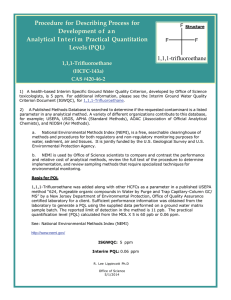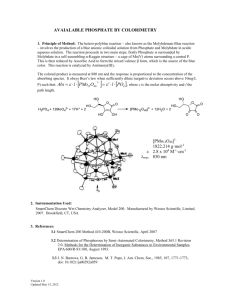Procedure for Describing Process for Practical Quantitation Levels (PQL)
advertisement
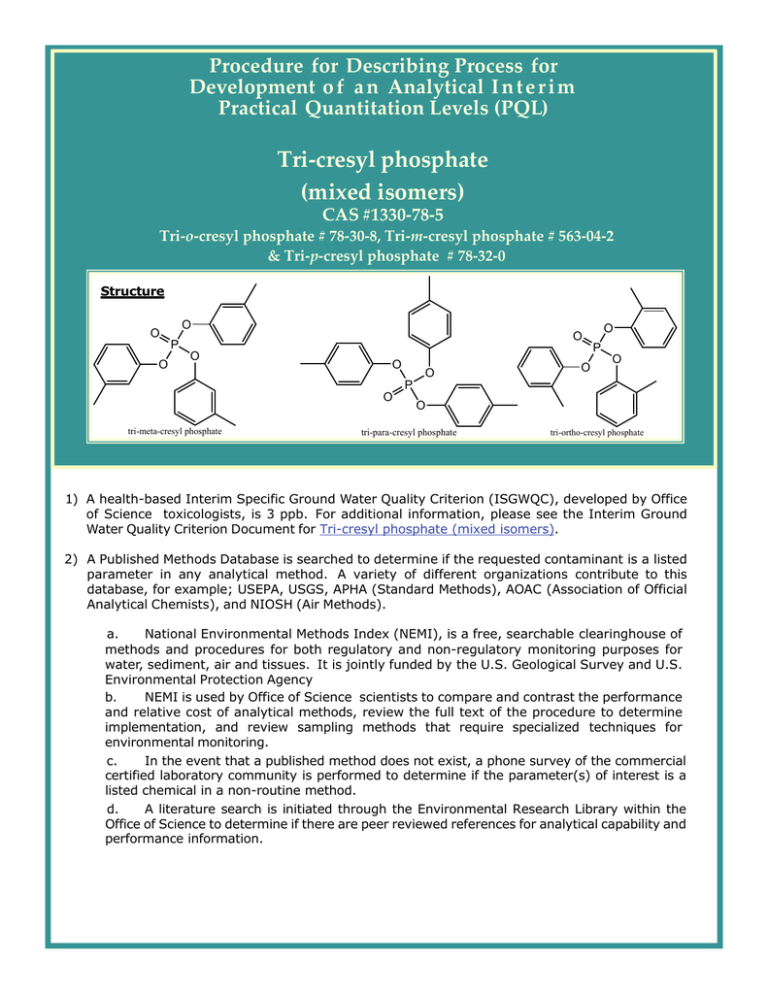
Procedure for Describing Process for Development o f a n Analytical I n t e r i m Practical Quantitation Levels (PQL) Tri‐cresyl phosphate (mixed isomers) CAS #1330‐78‐5 Tri‐o‐cresyl phosphate # 78‐30‐8, Tri‐m‐cresyl phosphate # 563‐04‐2 & Tri‐p‐cresyl phosphate # 78‐32‐0 Structure O O O P O O O O tri-meta-cresyl phosphate P O O O P O O tri-para-cresyl phosphate tri-ortho-cresyl phosphate 1) A health-based Interim Specific Ground Water Quality Criterion (ISGWQC), developed by Office of Science toxicologists, is 3 ppb. For additional information, please see the Interim Ground Water Quality Criterion Document for Tri-cresyl phosphate (mixed isomers). 2) A Published Methods Database is searched to determine if the requested contaminant is a listed parameter in any analytical method. A variety of different organizations contribute to this database, for example; USEPA, USGS, APHA (Standard Methods), AOAC (Association of Official Analytical Chemists), and NIOSH (Air Methods). a. National Environmental Methods Index (NEMI), is a free, searchable clearinghouse of methods and procedures for both regulatory and non-regulatory monitoring purposes for water, sediment, air and tissues. It is jointly funded by the U.S. Geological Survey and U.S. Environmental Protection Agency b. NEMI is used by Office of Science scientists to compare and contrast the performance and relative cost of analytical methods, review the full text of the procedure to determine implementation, and review sampling methods that require specialized techniques for environmental monitoring. c. In the event that a published method does not exist, a phone survey of the commercial certified laboratory community is performed to determine if the parameter(s) of interest is a listed chemical in a non-routine method. d. A literature search is initiated through the Environmental Research Library within the Office of Science to determine if there are peer reviewed references for analytical capability and performance information. Procedure for Describing Process for Development o f a n Analytical I n t e r i m Practical Quantitation Levels (PQL) Tri‐cresyl phosphate (mixed isomers) CAS #1330‐78‐5 Tri‐o‐cresyl phosphate # 78‐30‐8, Tri‐m‐cresyl phosphate # 563‐04‐2 & Tri‐p‐cresyl phosphate # 78‐32‐0 (Continued) Basis for PQL Tri-cresyl phosphate isomers, and their synonyms Tri-tolyl phosphates, appear as listed parameters in two published USEPA methods “1618, Organo-Halide Pesticides, Organo Phosphorus pesticides, and Phenoxy-acid Herbicides by Wide-Bore Capillary Column Gas Chromatography with Selective Detectors, and 8270D Semivolatile Organic Compounds By Gas Chromatography/Mass Spectrometry (GC/MS).” Although the meta and para isomers are not listed separately in the document, the chromatographic examples in the method indicate that they can be adequately resolved and that resolution can be improved further by the mass spectrometer resolution in the reconstructed ion chromatogram. The MDL used in the published methods is 10 ppb which would calculate to a PQL value of 50 ppb which is above the ISC level of 3 ppb. A laboratory survey and literature review were conducted due to the rather high PQL calculation and the literature survey yielded several peer reviewed references from MDL values of 20 ng/L to routine quantification values from environmental assessments of 0.3 to 4.3 ng/L sensitivity levels. In addition, USGS method O-1423-01 has a reporting limit (RL) of 60 ng/L for the flame retardant Tri-phenyl phosphate which is structurally similar to these parameters. Labelled isotopes of the analytes could be used to further enhance the sensitivity for these compounds. The value of 20 ng/ L was selected from this review, and the calculated PQL is 5 X 20 ng/L or 0.1 ppb. Labelled isotopes of the analyte could be used to further enhance the sensitivity for this parameter. The value of 20 ng/L was selected from this review, and the calculated PQL is 5 X 20 ng/L or 0.1 ppb. ISGWQC: 3 ppb Interim PQL: 0.1 ppb See: National Environmental Methods Index (NEMI) for the published USEPA methods http://ww.nemi.gov/ and the following references for the PQL determination; (1) Williams DT, Lebel GL; Bull Environ Contam Toxicol 27: 450-7 (1981) (2) Williams DT et al; Chemosphere 11: 262-76 (1982) (3) Ishikawa S et al; Water Res 19: 119-25 (1985) (4) Takimoto K et al; Atmos Environ 33: 3191-3200 (1999) (5) Marklund A et al; Environ Sci Technol 39: 3555-3562 (2005) (6) van der Veen I, de Boer J; Chemosphere 88: 1119-53 (2012) R. Lee Lippincott Ph.D Office of Science 3/19/2014
